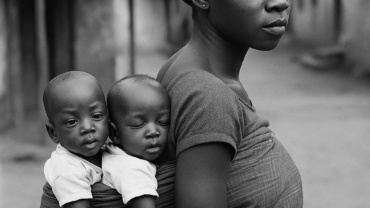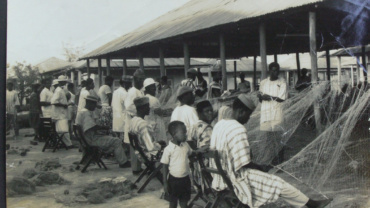In Ayetoro of the 1950s and 1960s, life was not defined only by worship and work. It was also full of play, energy, and joy. Among the most cherished pastimes of the town’s young people was football, played not on grass fields or manicured pitches, but on sandy open ground carved out between homes and shoreline. These matches, often spontaneous, were more than games; they were celebrations of community spirit and youthful vitality in the Happy City.
The sandy fields had no goalposts in the conventional sense. Instead, stones or sticks were placed at either end to mark the posts. The ball was often a prized possession — sometimes leather, sometimes improvised from tightly wrapped cloth. Yet, despite the lack of equipment, the matches carried a seriousness that mirrored the great competitions of the wider world. Young boys divided into teams, cheered on by peers, and the open ground filled with dust and laughter as the game unfolded.
Archival photographs from the period capture the raw energy of these matches: boys barefoot, their garments tucked high, chasing the ball with determination across uneven sand. Oral testimonies recall the sound of shouts rising above the town, neighbours gathering along the edges to watch, and the joy that spread from the players to the spectators. For many, these games were the highlight of the week, moments when work and school gave way to the freedom of play.
Football in Ayetoro was more than recreation; it was also a school of discipline and cooperation. Young people learned teamwork, strategy, and endurance. Elders often remarked that the same unity required to dig canals or build bridges was evident in the way boys passed the ball, defended their goal, or celebrated a victory. The matches taught lessons of resilience, fairness, and respect — qualities that reflected the community’s broader values.
Market days and festivals sometimes added extra excitement, with matches organised as part of the celebrations. On such occasions, larger crowds gathered, and even elders joined in the cheering. Victories were celebrated not with trophies but with songs, handshakes, and shared meals. The pride of winning was less about personal achievement and more about honouring the cluster of families represented by a team.
Visitors to Ayetoro in those years often remarked on the vibrancy of the youth and the communal joy found in their games. Some compared the scenes to international football in miniature, while others saw in the dust and laughter a unique expression of Aiyetoro’s resilience — a town that, despite its challenges, made room for joy.

Today, with much of the sandy open ground lost to the encroaching sea, the memory of those matches holds special significance. Elders recall with fondness the days when barefoot boys turned patches of sand into fields of dreams, when shouts and laughter filled the air, and when the spirit of play reflected the larger spirit of the town.
As one former player recalled: “We had no stadium, no boots, sometimes not even a proper ball. But on that sandy ground, we felt like champions.”




